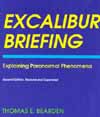
| 87. H-field: historically, the magnetic field. However, it is poorly named, and should be considered the magnetic excitation, after Sommerfeld. In empty space B and H are proportional, an experimentally determined fact. In the new approach, rigorously vector fields cannot exist in vacuum, but can only exist on an observable mass. A "shadow" vector field can exist in vacuum, in the absence of observable mass, as small virtual vectors, each existing on a virtual particle in the vacuum. Such a "shadow" vector field may be regarded as two coupled scalar fields, where the coupling is performed by the virtual particle flux of which the vacuum itself consists. When an observable, spinning charged mass encounters the shadow vector field, it converts the two coupled scalar fields into a vector field. Thus Hertz waves per se are not transmitted through vacuum; "shadow" Hertz waves are. With an ordinary detector, however, one detects vector Hertz waves, since one detects the precession waves of the electrons in the electron gas of the detecting probe or antenna. |